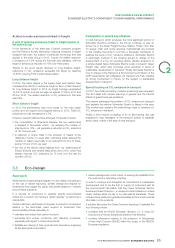APC 2012 Annual Report Download - page 60
Download and view the complete annual report
Please find page 60 of the 2012 APC annual report below. You can navigate through the pages in the report by either clicking on the pages listed below, or by using the keyword search tool below to find specific information within the annual report.
2012 REGISTRATION DOCUMENT SCHNEIDER ELECTRIC58
SUSTAINABLE DEVELOPMENT
2GREEN AND RESPONSIBLE GROWTH DRIVING ECONOMIC PERFORMANCE
A common frame of reference: Our Principles
ofResponsibility
Our Principles of Responsibility is a 15-page document that is as
pragmatic and realistic as possible, a synthesis of the Group’s
common commitments to employees, partners, shareholders,
the planet and society. Our Principles of Responsibility do not
claim to cover all ethical dilemmas, but rather serve as a general
guideline. They are adapted locally to meet local practices or legal
requirements.
Our Principles of Responsibility were prepared in compliance with
the 10principles of the Global Compact, the corporate governance
principles, the Universal Declaration of Human Rights and the
International Labor Standards. As a result, these principles comply
with international standards such as the anti-corruption principles.
Today, Our Principles of Responsibility document has been
translated into 30languages and sent to all Group employees.
A clause was added to all employment contracts, specifying that
new arrivals were aware of Our Principles of Responsibility when
they joined Schneider Electric.
Adapted processes
The Responsibility & Ethics Dynamics program provides each
employee with a method for asking the right questions and seeking
out the right people according to two approaches:
•a detailed questioning process to take the right steps in delicate
situations. This may be broken down into three stages:
1. consulting the program’s Intranet site,
2. contacting one’s manager and/or a member of the
concerned department (legal, fi nancial, human resources
(HR), environment, etc.),
3. contacting the entity’s Principles of Responsibility advisor;
•an alert process to guide employees step-by-step towards the
right bodies:
1. contact their line managers,
2. use existing in-house outlets (legal, fi nancial, HR, environment,
etc.),
3. contact the Group Compliance Committee.
Three tools accessible to all employees for
educational and prevention purposes
•An Intranet site accessible to all employees from the global
Intranet home page, providing all information on the program and
Our Principles of Responsibility, as well as news and progress in
the fi eld.
•Frequently Asked Questions – FAQs. This tool which is continually
powered was introduced following a collection of reports written
by the managers after the program and Our Principles of
Responsibility were presented to their teams.
•An online e-learning module. The aim is that, at the end of
the session, the trainee will be familiar with Our Principles of
Responsibility and more comfortable using them in his or her
job. At the end of 2012, more than 30,000 employees had
participated in the module: 94% rated the module as good or
excellent.
A professional alert system
To allow each employee to exercise their right to report a problem,
a professional alert system has been deployed over the past two
years. At the end of2012, it is 96% deployed; the goal is to cover
all employees.
In compliance with local legislations, this market solution is provided
by an independent company and proposes alert categories, a
questionnaire, and information exchange protocol between the
person issuing the alert and the person responsible for investigating
it. The main players in this process are the Compliance Offi cers (see
“Dedicated teams and organization”).
Implementation for the whole Group is accompanied by an internal
communication plan that identifi es the persons responsible for
investigating alerts received.
Dedicated teams and organization
The program requires implementation of an organization including
the following:
•a Governance Committee and a network of Principles of
Responsibility Advisors.
They are responsible for the implementation and roll out of the
Responsibility&Ethics Dynamics program ;
•a Compliance Committee and a network of Compliance Offi cers.
They are responsible for detecting and managing cases of non-
compliance with the processes defi ned, in line with local laws and
regulations and Our Principles of Responsibility.
Stakeholders and committees exercise their authority within
activities of infl uence and control.
In particular, the Governance Committee must ensure coherence
with the Group’s strategic plans. It provides Executive Committee
members with information on trends that, for example, implement
the company change program.
Governance
Committee
Compliance
Committee
Executive
Committee
One a year Twice a year Upon Request
Dene, Explain
& Spread the Rules
Detect & Manage
Non Compliance
PoR Advisers
(1 per Entity)
Compliance
Ocers
(1 per geograph. area)
Measuring rollout and effectiveness
The Responsibility & Ethics Dynamics program is primarily the
subject of regular internal communication. The objective is to inform
all the employees and remind the management teams of the priority
actions that they must drive forward, dependent on the risks to
which they are exposed in their countries of operation.
























